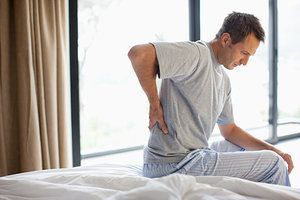When we talk about fertility, the focus is often placed on the ovaries and the uterus. Yet sperm-related factors contribute to nearly half of all cases of infertility. Whether someone is navigating fertility care alone or with a partner, and whether building a family through intercourse, IVI, IUI or IVF, it’s vital to include sperm health in the picture.
Chemistry & Pain: Understanding the Perfect Storm
"It only makes sense to recommend lifestyle changes to improve chemical balance while treating pain." – Dr. Dustin Dillberg
In Part 1 (March 2019), we discussed looking at physical pain a different way and identifying potential reasons away from the site of symptom. These include movement pattern imbalances, compensations, muscle tension issues, scar tissue/adhesions, and suboptimal neural firing patterns. All of these help us identify "WHY" the symptom is happening "WHERE" it is. However, there are many other factors that contribute to what I commonly refer to as the "perfect storm" of circumstances that resulted in the current health situation, whatever that may be.
Understanding the Pain
I'm sure we have all been there, a patient tells us, "I don't understand why I am in pain ... doc, can you tell me what the cause is?" Of course, we want to help our patients and we also want to provide them with an amazing answer, but is there only one cause? Is there only one reason that this has occurred? Or is there one thing we could have had them do different that would have cured the whole issue?

Maybe, but I usually lay out the many contributing factors that I have identified (knowing there are most likely even more I haven't identified) that all play a role. A "perfect storm" of physical, chemical, emotional, and environmental factors that have landed us where we stand today. It is all connected, and we should as often as possible, look to assess other associated imbalances if we are to treat the cause of disease rather than just the symptoms of disease.
The human body is infinitely wise. It does not surprise us that improving the balance of lifestyle factors including diet, movement, stress, breathing, and relaxation often reduces or eliminates many ailments including pain. So as TCM practitioners working in a society that is riddled with pain, with a medicine touted for its ability to treat pain, I believe it is our duty to further impact our patients who are suffering by providing additional lifestyle recommendations in addition to our wonderful herbs, treatments, and acupuncture.
The New Normal
It has become commonplace for chronic inflammation to be considered normal. Most of my patients when interviewed on their first visit, are prescribed more than one medication. These might be for high cholesterol, blood pressure, anxiety, depression, GERD, allergies, and or pain. Many of these medications have been shown to influence certain nutrient deficiencies through depletion or reducing absorption.
The average American diet tends to be highly processed, low in nutrient density, and contain many components that are considered pro-inflammatory. Nutritional deficiencies have numerous implications on our health including relation to fibromyalgia, arthritis, neuropathy, osteoporosis, muscle spasms, acute, and chronic pain.
I have identified digestive weakness in an overwhelmingly majority of my patients also, including leaky gut, poor stomach acid production, decreased pancreatic enzyme production, gallbladder dysfunction, and inflamed intestines/colon. If our patients are eating poorly, medicated (which may change digestion, absorption, and nutrient balance), and have weakened digestive systems it only makes sense to recommend lifestyle changes to improve their chemical balance while treating pain.
Lifestyle Factors
Dehydration
Deficient water intake can cause plenty of symptoms, but one of these that is often overlooked is pain. I have the belief that anything that increases the rate of cramping, spasms, and tension, should be looked at for its role in pain. Let's consider a couple aspects of hydration. First, our spinal discs are largely made up by water. If our tissues are systemically and/or chronically dehydrated it only makes sense to me that this can contribute to thinning and stressed discs. Second, concentration of inflammatory compounds and can increase with dehydration. Improving the hydration status of our pain patients may contribute to the effectiveness of our treatments and assist in lymphatic processing of inflammatory waste products.
G.I. Inflammation & Leaky Gut
Modern science has made a connection between serotonin and pain. Serotonin assists in regulation of far more than just mood, but also pain perception and a host of other functions I will leave for another article. This is why serotonergic drugs are prescribed for headaches, chronic pain management, and fibromyalgia. It is estimated that 90-95 percent of all serotonin is produced in the gastrointestinal tract.
Second, leaky gut can let undigested food particles into your system triggering an inflammatory cascade. This type of stress may be adding to the "perfect storm" mentioned earlier. The gut-brain connection can also be thought of as a gut-pain connection.
Adrenal Fatigue
After working overtime in a very stressful world, our poor adrenal glands get a lot of blame in our current medical newsreel. The over-excitement, stimulus, and eventual exhaustion of these little powerhouses can make sense of slower healing times and elevated inflammation. Supporting the wellness and healing of the adrenal glands through lifestyle, herbs, and vitamins can act as a supercharger to our acupuncture treatments.
There are many nutrient, vitamin, and mineral deficiencies associated with pain and inflammation. A few include:
- Omega-3 essential fatty acids: A critical set of lipids for optimal function of many systems in the body. Often touted as a powerful anti-inflammatory for musculoskeletal issues, Omega 3's are also widely accepted as helpful in a wide variety of cardiovascular, neurological, and autoimmune conditions. It is important to not only get abundant amounts of omega 3's but also to achieve optimal ratios between them and omega-6's and other inflammatory markers. I like to suggest a simple blood spot test that patients can do themselves. This accurately measures current levels/ratios while adding great amounts of scientific evidence to dietary, lifestyle, and supplement recommendations. Due to the commonly weak digestive function discussed earlier, I use monoglyceride forms of omega 3 fatty acids and have been pleased with some incredible results.
- Magnesium: Most commonly thought of helping cramps and spasms, magnesium actually facilitates the function of over 300 critical enzymes, making it one of the most important trace elements. This vital mineral ends up influencing many metabolic functions, which can affect a multitude of processes including how our body both contracts and relaxes muscle tissue, manufactures DNA, produces energy, and even plays a role in the production of glutathione. Poor mental clarity, memory recall, and heartbeat rhythm are also considered some other signs of magnesium deficiency. Since multiple studies have linked low magnesium with different types of pain I believe supplementation or topical application can be a wonderful addition to traditional TCM recommendations.
- Vitamin D: I am shocked by the high occurrence of low vitamin D levels in my patients. Even though my patients live in Hawaii and usually have a good tan, many have low vitamin D levels without supplementation. I am learning that this may stem from a somewhat common genetic tendency. Like magnesium and omega 3's, vitamin D is quite a hard worker. Optimizing levels can help with inflammation levels and also commonly improves mood states and energy levels.
- B Vitamins: Yes, this is a category and each one of the B-vitamins are unique and important. For the sake of time and space I have included them as a group as they are commonly supplemented that way. Some of the benefits of these compounds support the nerves and their myelin sheath, thus helping with multiple types of neuropathy and pain. Without proper levels of B vitamins, methylation and energy production suffer. B3 has been shown to improve osteoarthritis symptoms of joint stiffness, discomfort, and inflammation. Genetic predispositions leave a large percentage of the population unable to metabolize the "inactive" forms of folic acid and B12. It is wise to determine through genetic testing if your patient has any difficulty with this process or use the methylated forms of these nutrients in supplementation.
In an effort to continually further our knowledge and understanding of the human body and its health, I am encouraged to seek from both East and West. With the utmost respect for TCM, our tried and true medicine, integration with functional medicine techniques has proven incredibly valuable to my practice. It is my hope that this article inspires and sparks excitement to better serve all those around us.
My Lifestyle Checklist for Pain Patients
- Assess medications for potential depletion
- Investigate gut health
- Get a diet diary and counsel on nutrition
- Identify stress levels and ability to adapt to stressors
- Check for dehydration signs
- Question chemical exposures
- Look for lifestyle imbalances
My Recommendations
- Breathing exercises and meditation
- Healthy movement and exercise
- Sun exposure and/or vitamin D
- Hydration
- Quality sleep



